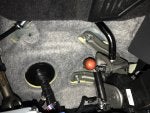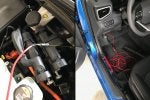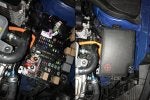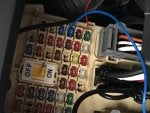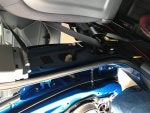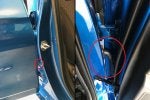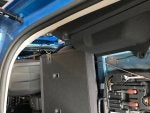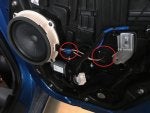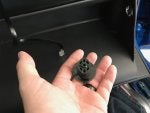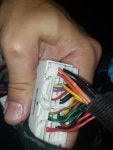I’ve put together a guide for wiring an amplifier into a USA Spec Hyundai Ioniq Hybrid without the premium Infinity sound system.
I’ve seen a few people asking how to do this since there’s no traditional 12V lead-acid battery in these cars so I put together a guide for whoever may need it.
Disclaimer: I am not responsible for your vehicle or you if you mess something up. This guide is to help people who have a moderate understanding of vehicle electrical/stereo systems and need a little extra help in figuring out this rather complicated vehicle.
Also, please be aware that you are working with electrical components. Do not move forward with this guide unless you have a moderate understanding of how to install car stereo equipment, or do not feel comfortable doing this. While a shock from a 12V system can be a bit painful and scare you, a shock from the 240V system can and will kill you. If you’re following this guide you won’t be messing with any wiring that has to do with the 240V system. But if you don’t know what you’re doing and disconnect or dig into something you shouldn’t, you might.
Things Needed:
Amplifier (I’m using the Rockford Fosgate PBR300X1 for this guide.)
Amp install kit (Depending on amp and subs this can vary. I used the Rockford Fosgate RFK10 kit for this install.)
Speaker Wire (I purchased 16 Gauge, but it may be easier if you use something smaller to get through the door, however 16 Gauge is what is recommended for the amp speaker connections on the amp I’m installing.)
Rockford Fosgate RFI2SW Speaker Line to Male RCA Adapter (If installing as High Level input to same amp used in this guide.)
Remote Punch EQ (PEQ) – Optional
Socket wrench
10mm socket
12mm socket
Philips head screw driver
Coat hanger
Flash light
Wire stripper/cutter
Quick connects or soldering iron
Needle nose pliers
Power Wire Install
First thing you’ll want to do is pop the hood. You’ll then want to unbolt the box in the below picture with the 10mm socket. It has three connection points, one up top and two at the bottom. You may need some extensions to get to the two bottom ones. Also, go ahead and remove the mat and tire inflation kit from your trunk area so you have more room to work with once you get to that step.
![Image]()
Once you have it unbolted you can lift it up a bit and pull it towards the front and center of the car. You’ll need to do this unless you have small hands and can get behind this with no issues, or if you can get a hold of the coat hanger without doing this step.
Back inside the car under the dash near the emergency break there is a rubber grommet which you’ll need to push/pull through to have an access point through the firewall. I had a screwdriver going through the firewall in the photo so I could identify where it came out on the engine bay side.
![Image]()
*It’s worth noting here that this worked with a 10 gauge wire. I’m using a PBR300X1 amp from Rockford Fosgate as it is a highly efficient amp designed to be used on Motorcycles and ATVs. Given that this electrical system is supposedly pretty limited due to not having a traditional 12V battery, I went this route. You may be able to get away with a slightly larger wire with a different amp. I did not test this however.*
You’ll want to then push a coat hanger through the firewall hole where you moved the grommet from the interior to the engine bay.
Once you have that, you can tape the power wire to it to pull it from the engine bay through the firewall to the interior. While it will involve pulling almost all of the wire through, you need to do it this way if you have an inline fuse already pre-installed into the wire as you will not be able to push the fuse part of the wire through the driver’s area to the engine compartment.
![Image]()
Once you’ve pulled it through the firewall you’ll want to carefully thread all of the wire through (like above) up till you have just enough under the hood to route it and connect it to a connection under the fuse box. Do not hook the power wire up just yet. You can go ahead and bolt the box back on you unbolted earlier.
![Image]()
You’ll then want to route the wire under the trim (as demonstrated in the above right photo) to the back of the car starting by pulling all of the wire back behind the emergency break and hood release working your way to the back seats. The middle trim on the front door is removable by lifting straight up on the ends and then middle. However, it isn’t 100% necessary to remove the trim to route the wire.
Then you’ll want to run it under the trim up to and under the seat as shown below. You may need two people to push the wire under the seat to the hatch/trunk area as shown. I had a friend help me do this but you can do it yourself if necessary. It will just take some extra time.
![Image]()
You’ve now successfully routed the power wire.
*If you’re ready to wire the power wire to the car you can follow the below step, if not, skip to the ground wire section and come back to this later.*
Make sure to remove the in-line fuse before doing this step. To hook the power wire to the car’s electrical system you’ll need to unbolt the connection with a 10mm socket, install the wire, and reinstall the nut as shown. You can then run the power wire down the side of the box along the side of the other wire running down the side of the box, and reinstall the cover.
![Image]()
I’ve seen a few people asking how to do this since there’s no traditional 12V lead-acid battery in these cars so I put together a guide for whoever may need it.
Disclaimer: I am not responsible for your vehicle or you if you mess something up. This guide is to help people who have a moderate understanding of vehicle electrical/stereo systems and need a little extra help in figuring out this rather complicated vehicle.
Also, please be aware that you are working with electrical components. Do not move forward with this guide unless you have a moderate understanding of how to install car stereo equipment, or do not feel comfortable doing this. While a shock from a 12V system can be a bit painful and scare you, a shock from the 240V system can and will kill you. If you’re following this guide you won’t be messing with any wiring that has to do with the 240V system. But if you don’t know what you’re doing and disconnect or dig into something you shouldn’t, you might.
Things Needed:
Amplifier (I’m using the Rockford Fosgate PBR300X1 for this guide.)
Amp install kit (Depending on amp and subs this can vary. I used the Rockford Fosgate RFK10 kit for this install.)
Speaker Wire (I purchased 16 Gauge, but it may be easier if you use something smaller to get through the door, however 16 Gauge is what is recommended for the amp speaker connections on the amp I’m installing.)
Rockford Fosgate RFI2SW Speaker Line to Male RCA Adapter (If installing as High Level input to same amp used in this guide.)
Remote Punch EQ (PEQ) – Optional
Socket wrench
10mm socket
12mm socket
Philips head screw driver
Coat hanger
Flash light
Wire stripper/cutter
Quick connects or soldering iron
Needle nose pliers
Power Wire Install
First thing you’ll want to do is pop the hood. You’ll then want to unbolt the box in the below picture with the 10mm socket. It has three connection points, one up top and two at the bottom. You may need some extensions to get to the two bottom ones. Also, go ahead and remove the mat and tire inflation kit from your trunk area so you have more room to work with once you get to that step.
Once you have it unbolted you can lift it up a bit and pull it towards the front and center of the car. You’ll need to do this unless you have small hands and can get behind this with no issues, or if you can get a hold of the coat hanger without doing this step.
Back inside the car under the dash near the emergency break there is a rubber grommet which you’ll need to push/pull through to have an access point through the firewall. I had a screwdriver going through the firewall in the photo so I could identify where it came out on the engine bay side.
*It’s worth noting here that this worked with a 10 gauge wire. I’m using a PBR300X1 amp from Rockford Fosgate as it is a highly efficient amp designed to be used on Motorcycles and ATVs. Given that this electrical system is supposedly pretty limited due to not having a traditional 12V battery, I went this route. You may be able to get away with a slightly larger wire with a different amp. I did not test this however.*
You’ll want to then push a coat hanger through the firewall hole where you moved the grommet from the interior to the engine bay.
Once you have that, you can tape the power wire to it to pull it from the engine bay through the firewall to the interior. While it will involve pulling almost all of the wire through, you need to do it this way if you have an inline fuse already pre-installed into the wire as you will not be able to push the fuse part of the wire through the driver’s area to the engine compartment.
Once you’ve pulled it through the firewall you’ll want to carefully thread all of the wire through (like above) up till you have just enough under the hood to route it and connect it to a connection under the fuse box. Do not hook the power wire up just yet. You can go ahead and bolt the box back on you unbolted earlier.
You’ll then want to route the wire under the trim (as demonstrated in the above right photo) to the back of the car starting by pulling all of the wire back behind the emergency break and hood release working your way to the back seats. The middle trim on the front door is removable by lifting straight up on the ends and then middle. However, it isn’t 100% necessary to remove the trim to route the wire.
Then you’ll want to run it under the trim up to and under the seat as shown below. You may need two people to push the wire under the seat to the hatch/trunk area as shown. I had a friend help me do this but you can do it yourself if necessary. It will just take some extra time.
You’ve now successfully routed the power wire.
*If you’re ready to wire the power wire to the car you can follow the below step, if not, skip to the ground wire section and come back to this later.*
Make sure to remove the in-line fuse before doing this step. To hook the power wire to the car’s electrical system you’ll need to unbolt the connection with a 10mm socket, install the wire, and reinstall the nut as shown. You can then run the power wire down the side of the box along the side of the other wire running down the side of the box, and reinstall the cover.



